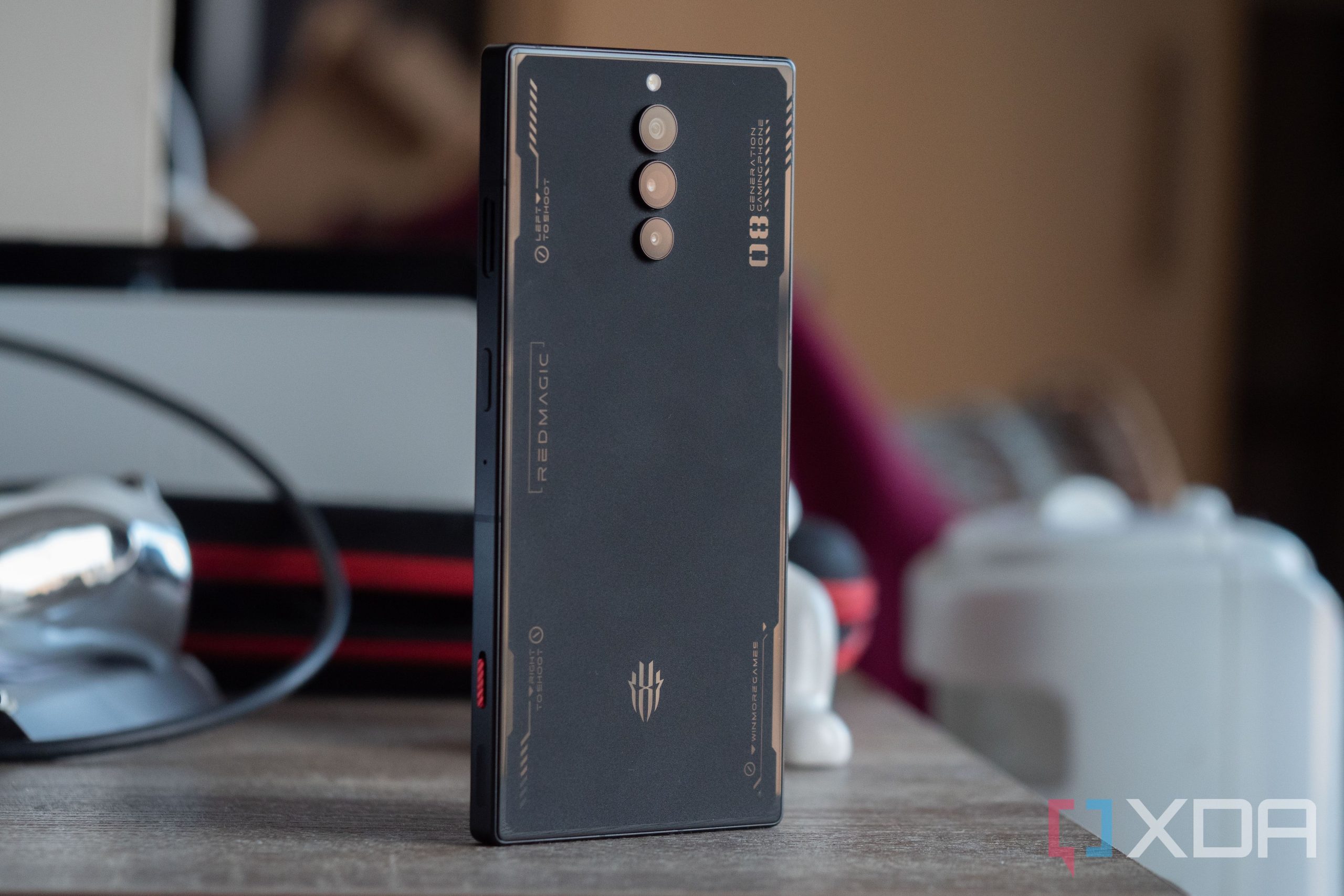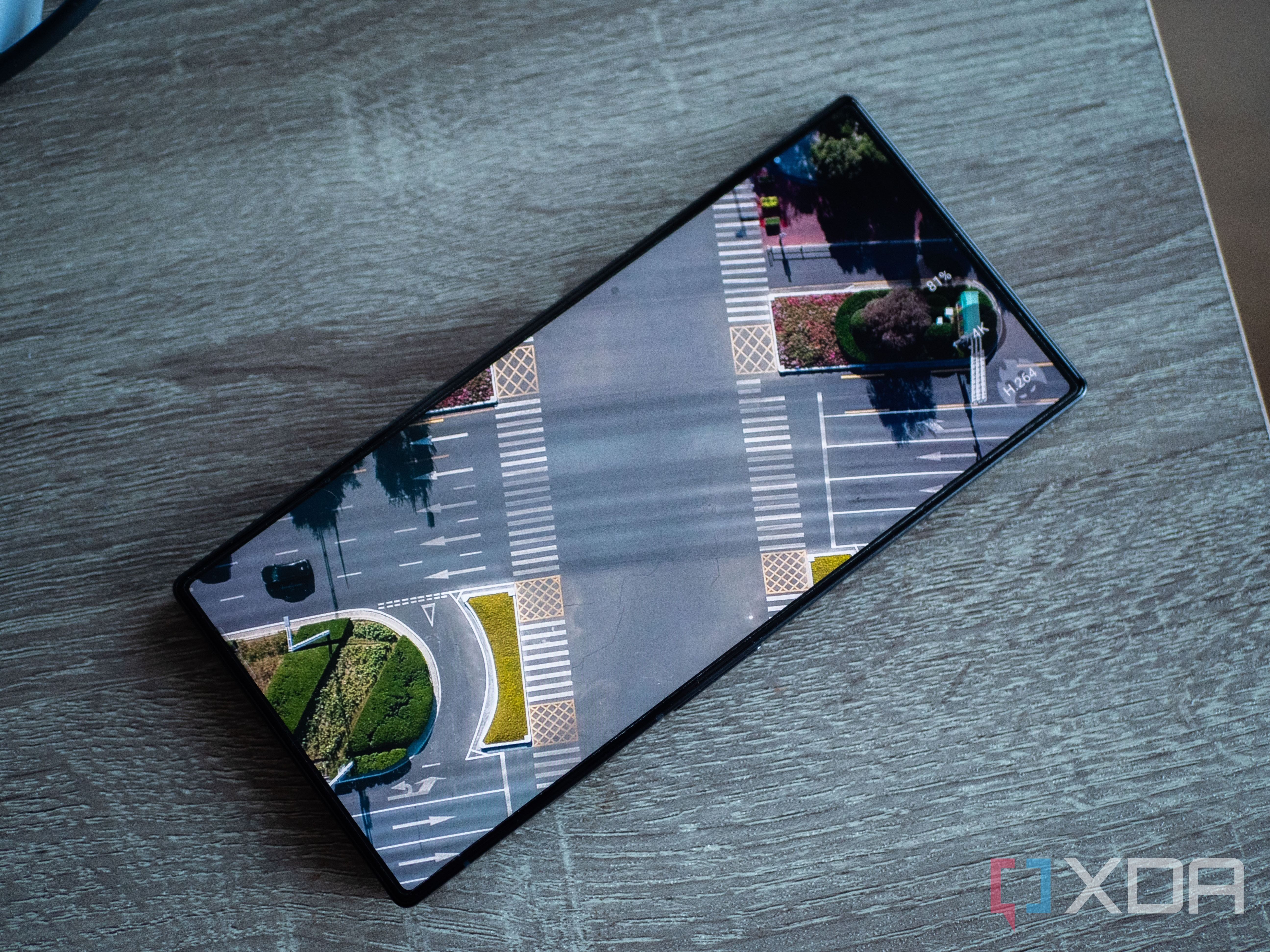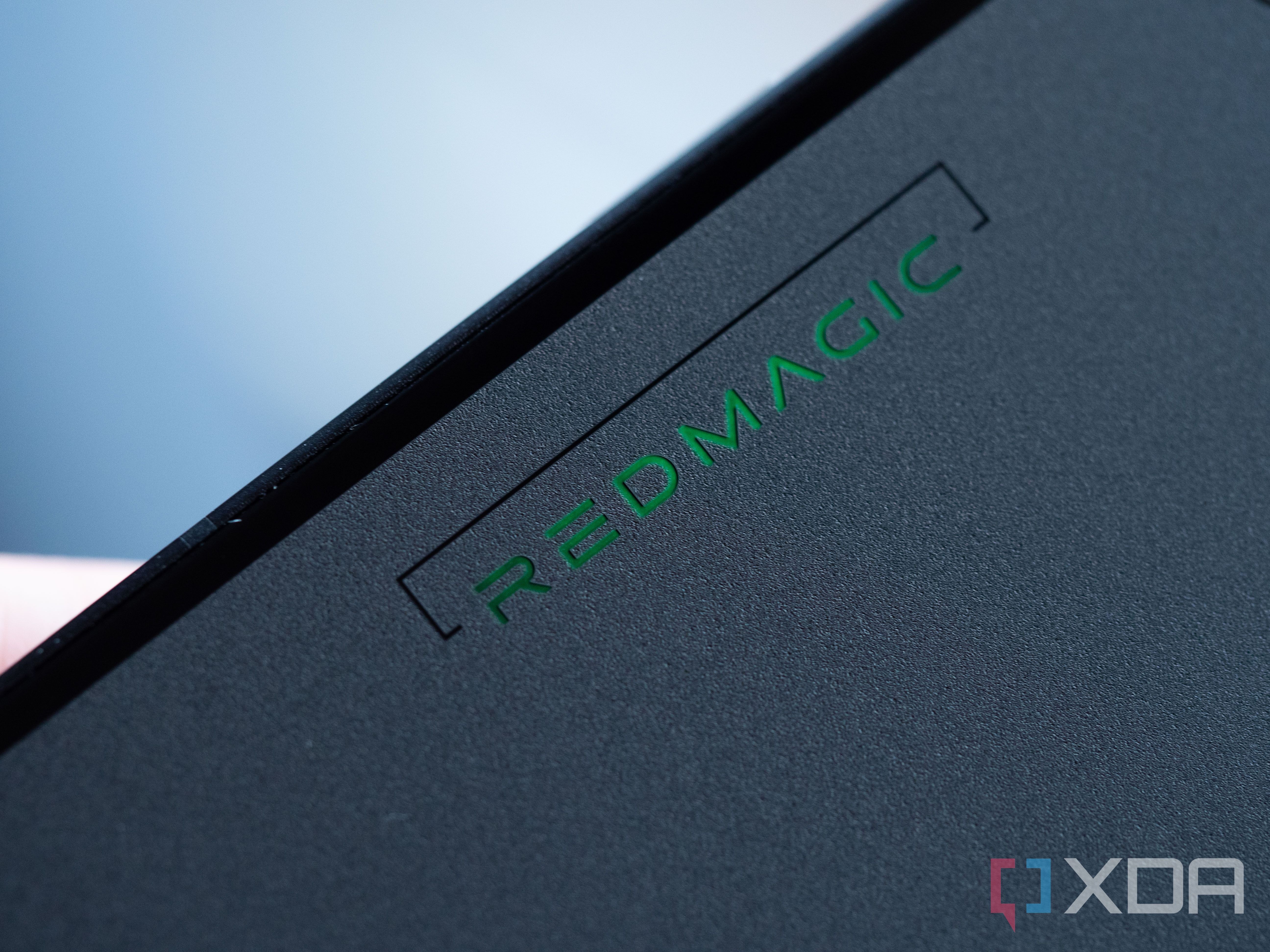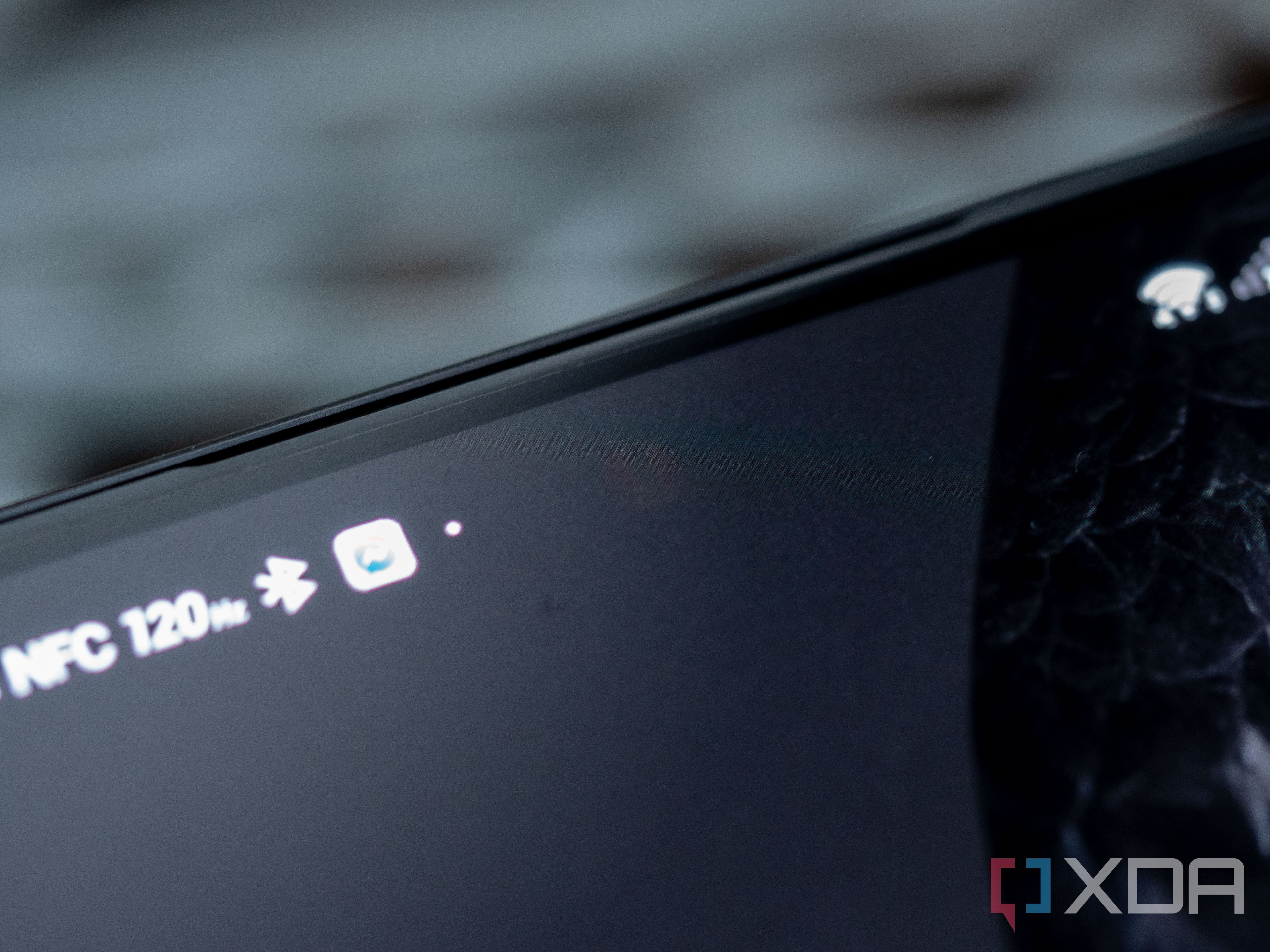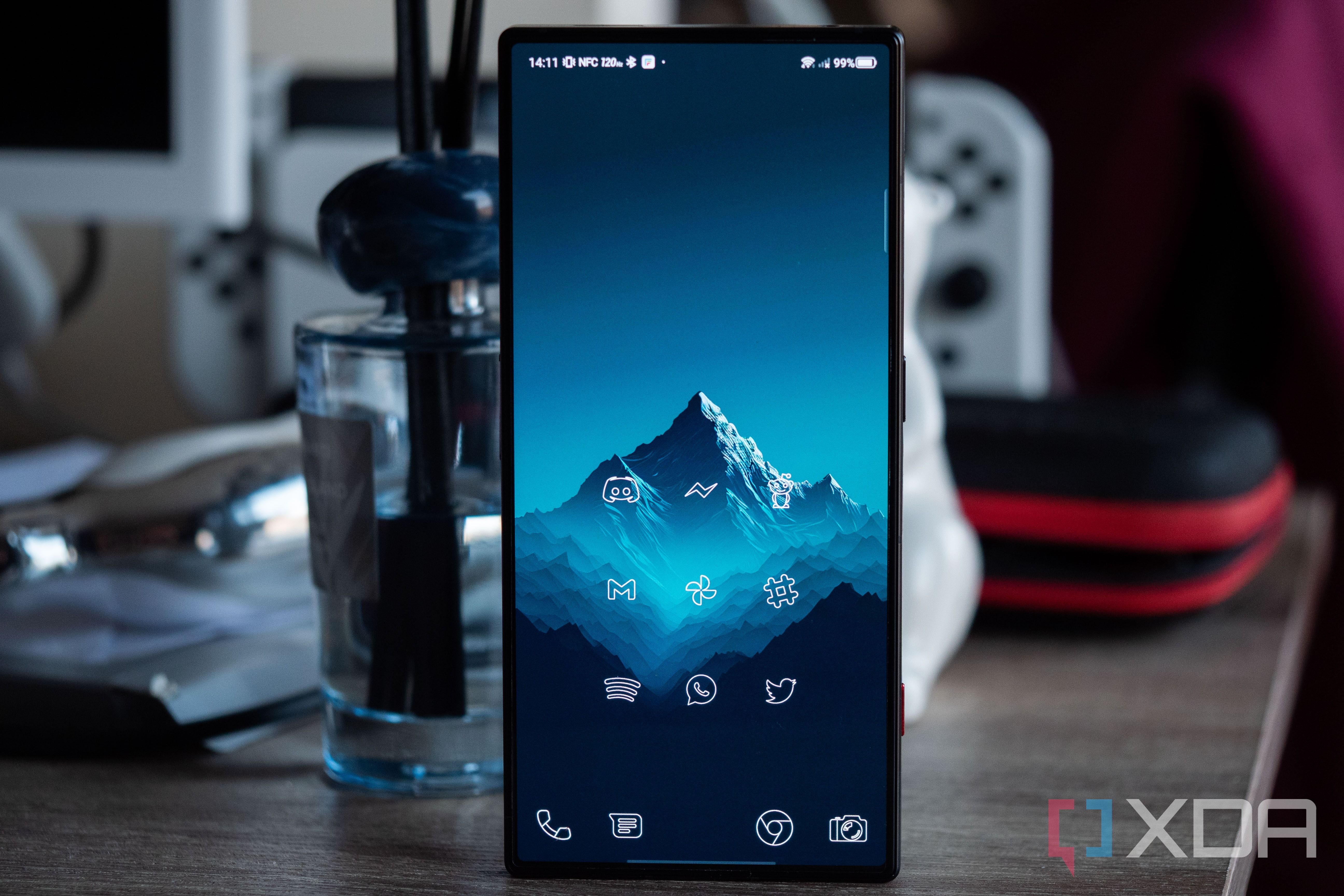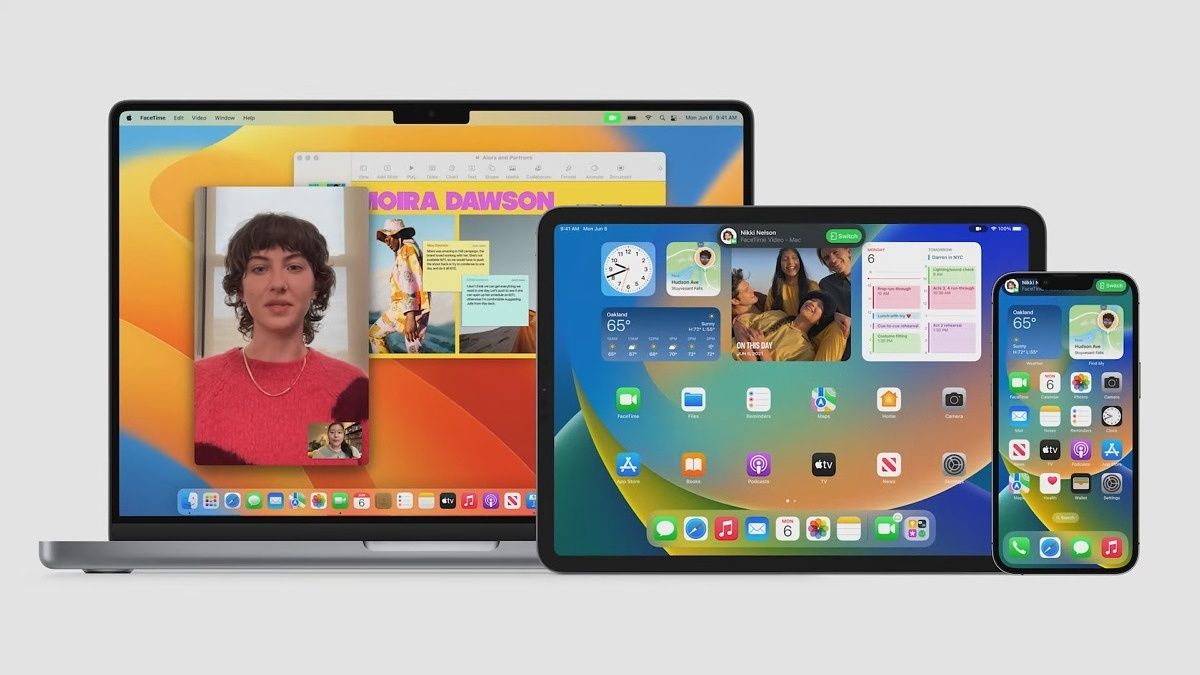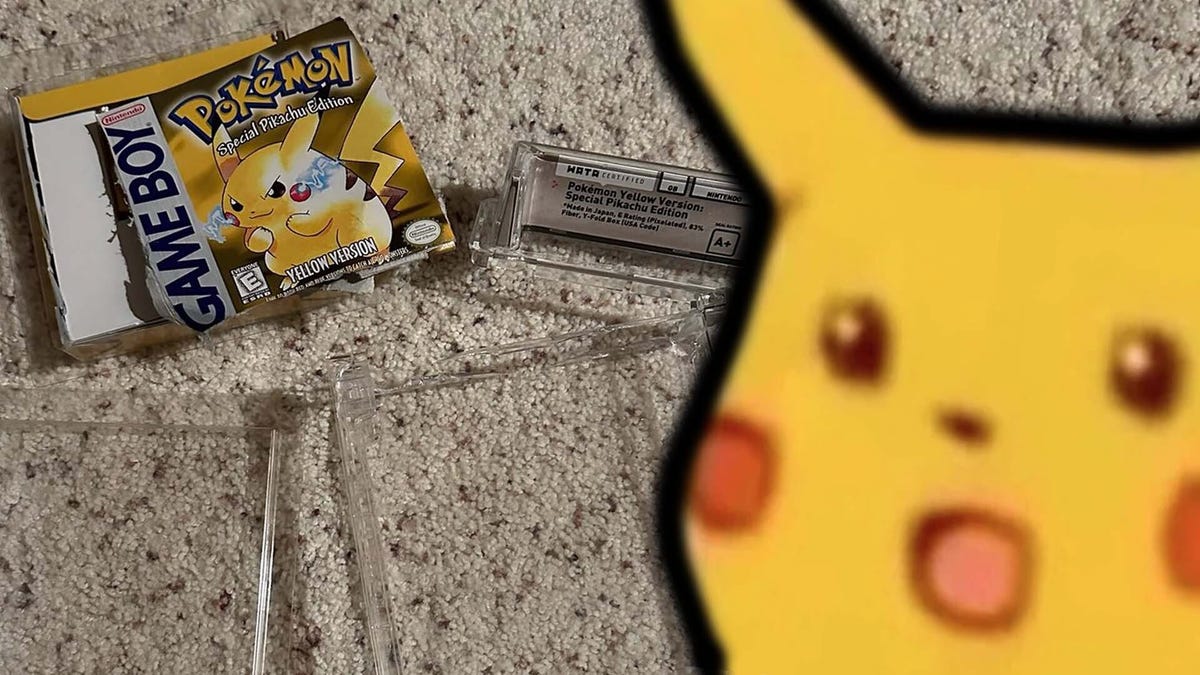There are very few smartphone brands that are known solely for gaming phones. The first is probably Asus with its stellar ROG Phone series (though it has an equally great Zenfone series), and the second is probably RedMagic. Gaming on a smartphone isn’t exactly a new concept, and with the Snapdragon 8 Gen 2, Qualcomm has been doubling down on some of what makes a gaming phone great.
That brings us to the RedMagic 8 Pro, one of the first phones to have Snapdragon 8 Gen 2 and, subsequently, one of the best gaming phones I’ve ever used. As is always the case with RedMagic, the 8 Pro is a fantastic smartphone that’s let down only by its software. I can use nearly any smartphone and have a decent time with it (I could even stomach ColorOS 6.1 back in the day when it looked exactly like iOS but worse), but the company’s OS is nearly unusable on a daily basis. Some aspects of the UI are great, but others are really, really terrible. Even the fantastic display and design of this device, along with its stellar performance, can’t make up for that.
If, however, you don’t mind what you see in the software realm and can stomach it for a unique-looking phone with an excellent display and an interesting design, then maybe the Red Magic 8 Pro is for you. It’s not a bad phone whatsoever and might be one of the most powerful smartphones you can purchase on the market today.
About this review: RedMagic sent me the RedMagic 8 Pro for review on Jan. 4, 2023. The company had no input into the contents of this review.
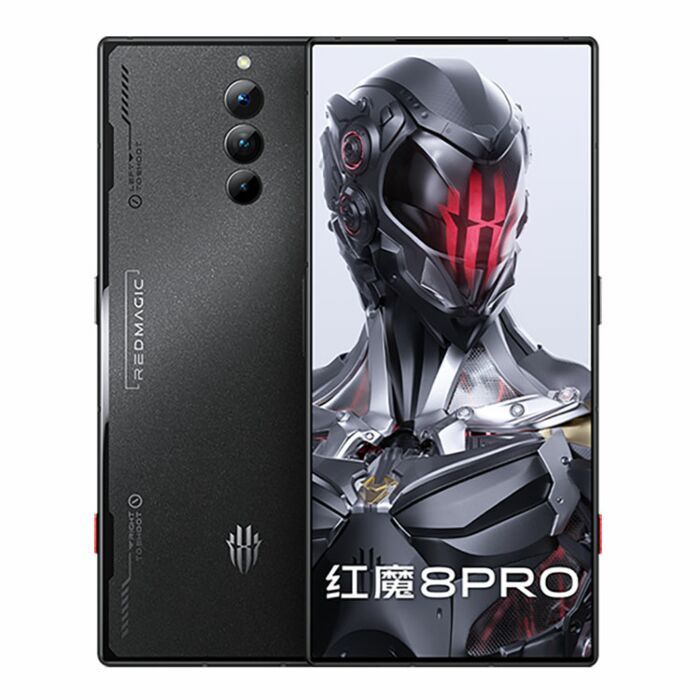
RedMagic 8 Pro
The RedMagic 8 Pro is a gaming smartphone that packs a lot of punch. With its incredible display, powerful hardware, and out-of-the-way front-facing camera, it’s a great first choice for a gamer. The only issue is the software.
- Brand
- RedMagic
- SoC
- Snapdragon 8 Gen 2
- Display
- 120Hz 1080p AMOLED
- RAM
- 12GB RAM
- Storage
- 256GB storage
- Battery
- 6,000 mAh
- Ports
- USB-C, headphone jack
- Operating System
- Android 13
- Front camera
- Under-display, 16MP
- Rear cameras
- 50MP, 8MP ultrawide, 2MP macro
- Dimensions
- 164 x 76.4 x 8.9 mm
- Colors
- Black
- Display type
- AMOLED
- Weight
- 228g
- Charging
- 65W, charger in box
|
Pros |
Cons |
|---|---|
|
Great design |
Software is terrible |
|
Beautiful display |
Poor front-facing camera |
|
Bezel-less design |
Unlikely to get updates |
|
Powerful hardware |
RedMagic 8 Pro: Pricing and availability
- Matte – 12GB RAM + 256GB at $649 / Є649 / £579 / 906.9 SGD
- Void – 16GB RAM + 512GB at $799 / Є749 / £709 / 1119 SGD
The RedMagic 8 Pro starts at $649 for the base model with 12GB of RAM and 256GB of storage. It’s available for purchase starting on Feb. 2, with early bird deals beginning on Jan. 28. It’s available from the following countries:
- North America: Canada and the U.S.
- Europe: Austria, Belgium, Bulgaria, Lithuania, Croatia, Luxembourg, the Republic of Cyprus, Czech Republic, U.K., Netherlands, Denmark, Poland, Estonia, Portugal, Finland, Romania, France, Slovakia, Germany, Slovenia, Greece, Spain, Sweden, Ireland, Hungary, Italy, Latvia, Malta
- Asia Pacific: Hong Kong (China SAR), Indonesia, Macau (China SAR), Philippines, Singapore, Malaysia
- Middle East: Israel, Kuwait, Saudi Arabia, United Arab Emirates, Egypt
- Latin America: Mexico, Peru, and Chile
Design: Beautiful with no bezels
- Unique design
- Great hardware
- Completely bezel-less
The Red Magic 8 Pro has one of the most unique smartphone designs I’ve seen in recent years. It’s very boxy, with squared-off sides and a much smaller radius curve for each display corner. The display is edge-to-edge, and an under-screen camera means that there’s no notch to speak of, either. That uninterrupted display is rare to experience nowadays, with ZTE being one of the main contenders putting under-display cameras in its flagships. This makes it a great media consumption phone, let alone a gaming phone.
Things get even more interesting on the back, though. There are the usual gaming insignias imprinted on the back, but nothing too cringey. However, going up the left-hand side of the back is a “REDMAGIC” logo and small stripes at the top and bottom. These light up like a notification LED, though in the color green, which I found a bit weird given that, you know, “Red” is in the name. You can change it in the settings to any color you want and customize it in other ways, so it doesn’t really matter.
Aside from that, the other big design addition here is a relatively quiet fan with an intake on the left and an outtake on the right. Interestingly, it didn’t seem to make much of a difference in any of my testing because the phone never really got hot in the first place, and I got consistently high performance regardless of if the fan is on. There are shoulder triggers on the right-hand side of the device that can be mapped to touch inputs, and I was pleasantly surprised to learn that the fan outtake didn’t push hot air over my fingers, which Asus did somewhat with the Asus AeroActive Cooler 6.
The speakers and the haptics are also both quite good. The speakers get loud (though don’t sound all that powerful), and the haptics are lovely for typing with. You’ll easily notice this one going off in your pocket.
Finally, there’s the under-display camera itself, which is surprisingly not noticeable. It can be a worry that with devices like this, the pixel density covering the sensor is much, much lower. It is definitely lower, and you can see it if you’re looking for it, but it’s not an eyesore like some earlier implementations of this tech.
Performance: Snapdragon 8 Gen 2 pumps up the power
- The most powerful smartphone yet
- The fan actually helps in some conditions
- Benchmark topper, as expected
This is our first look at the Snapdragon 8 Gen 2 in a smartphone, and the RedMagic 8 Pro bodes well for the future of devices. We’ve been putting it through its paces to see what this chip is capable of, and not only does it seem to avoid heating up too much, but it’s also capable of some powerful sustained performance.
If you’re not familiar with the Snapdragon 8 Gen 2, it skips the 1+3+4 core layout that we see in a lot of chipsets, as Qualcomm has instead opted for 1+4+3. This means one prime core, four performance cores, and three efficiency cores. What’s even stranger about this configuration is that it’s not just four performance cores that are the same; there are two A715 cores and two A710 cores. The A710 allows for AArch32, or 32-bit code execution, whereas the A715 drops 32-bit support. It’s unclear if this will have any impact on efficiency, as the A715 boasts a 20% efficiency improvement over the A710 and 5% better performance.
This is our first look at the Snapdragon 8 Gen 2 in a smartphone, and the RedMagic 8 Pro bodes well for the future of devices.
The prime core is an Arm Cortex-X3, which we clocked at 3.19GHz. At 3.3GHz, according to Arm, the Cortex-X3 will perform 25% faster in single-threaded operations than the Cortex-X2 at 2.9GHz. This is an architectural improvement that should still translate to higher performance even at a slightly lower clock speed than Arm’s own testing. The company also included three A510R1 cores as efficiency cores, otherwise known as A510 Refresh, and they support AArch32.
From what we can see, the Snapdragon 8 Gen 2 is every bit of a performance beast as we expected it to be. We’ll be sure to make some chipset comparisons in the future to compare to the likes of the 8 Plus Gen 1 and even Tensor G2, but for now, these tests are representative of the performance you can expect with the RedMagic 8 Pro. Interestingly, the built-in fans don’t really seem to do much for performance. We get the same results whether the fan is enabled or not.
CPU Throttling Test
CPU Throttling Test is a freely available app on the Google Play Store, and it repeats a simple multithreaded test in C for as short as 15 minutes. We increased the length of time to 30 minutes. The app charts the score over time to see when the phone starts throttling. The score is measured in GIPS — or billion operations per second. It’s essentially a test that can measure the sustained performance of a chipset.
As you can see, the RedMagic 8 Pro does a stellar job in this test even without the fan. However, this performance in CPU is incredibly high and has only been beaten in my experience by the MediaTek Dimensity 9000 Plus, which had massively overclocked performance cores when we tested it in the Asus ROG Phone 6D Ultimate.
In gaming mode (third screenshot), you can see how ludicrous the performance really is. It throttles to 93% of its total performance, and the phone wasn’t even too uncomfortable during that time. It definitely heated up more than in the other tests, but not in a way that there was any noticeable thermal throttling. In fact, it throttles the least out of any phone I’ve used in a long time.
I also tested the phone with gaming mode enabled and the fan switched off. You can see that performance dropped off a bit more than when the fan was on, pointing to how the fan seems to do something under intense workloads. Maybe not in normal usage (such as when the phone is fast charging), but it seems to be better than nothing for intense gaming sessions.
Geekbench and Antutu
Antutu is a holistic benchmark, and it tests the CPU, GPU, and memory performance, while including abstract tests and, as of late, relatable user experience simulations (for example, the subtest that involves scrolling through a ListView). The final score is weighted according to the designer’s considerations. Geekbench is a CPU-centric test that uses several computational workloads, including encryption, compression (text and images), rendering, physics simulations, computer vision, ray tracing, speech recognition, and convolutional neural network inference on images.
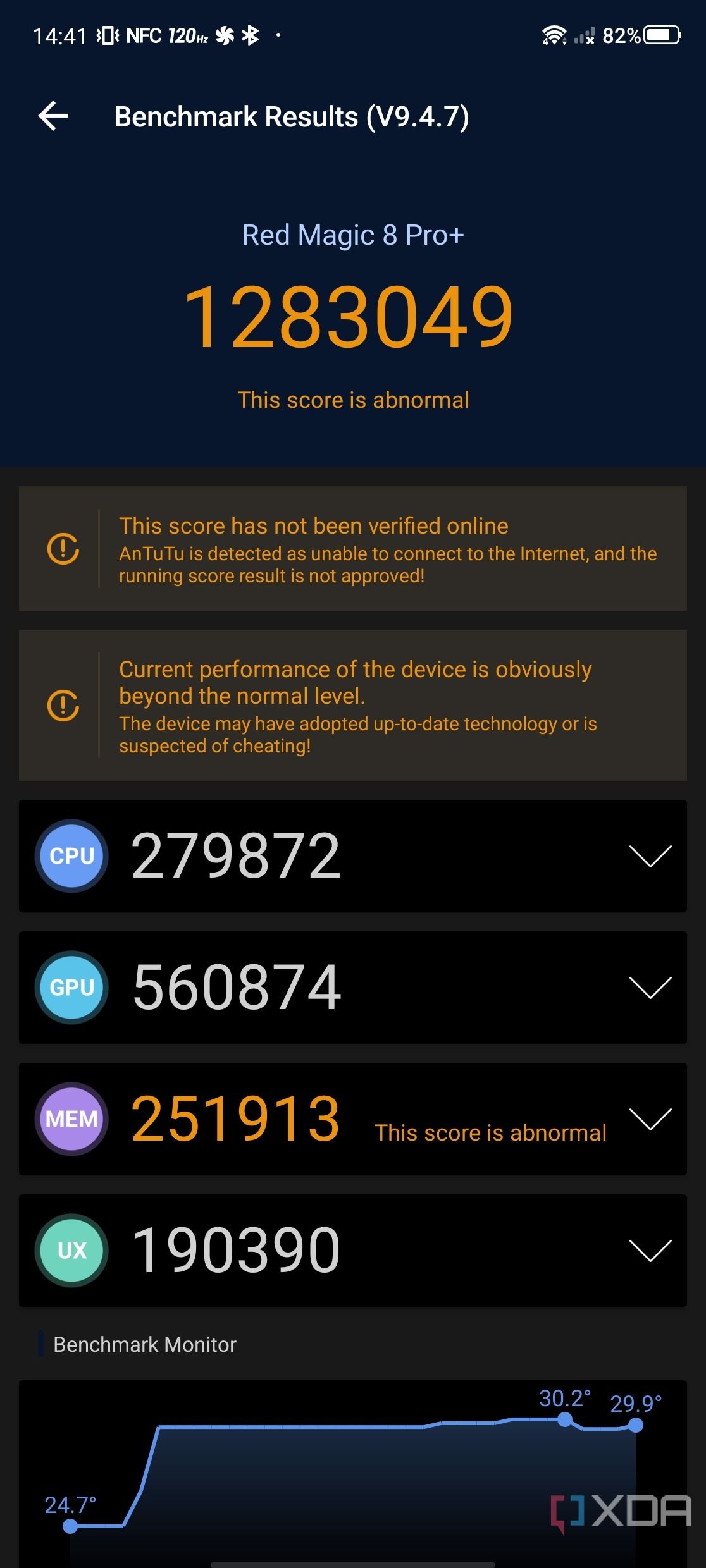

The scores received above are some of the highest on any Android phone thus far, though they are on par with what we expect from a Snapdragon 8 Gen 2 device. These were run with the fan on (which was enabled by default), though, as already mentioned, the fan being on doesn’t really seem to do a lot for the performance anyway.
GameCube Emulation
By virtue of being the most powerful Android smartphone already with the Snapdragon 8 Gen 2, it’s expected that all games on the Google Play Store will work near-flawlessly on it. That’s why I tend to look towards emulation when testing a new chip, and my go-to game is The Simpsons: Hit & Run in Dolphin Emulator. (I would have also included AetherSX2 for PS2 emulation, except I couldn’t get GameBench working on it.)
The Simpsons: Hit & Run runs the best I’ve ever seen on the RedMagic 8 Pro, and it’s impressive how consistent it is. It’s not a constant 60 FPS (and I’ve found that the GameCube version of this game runs worse than the PlayStation 2 version), but it’s close, and it’s certainly playable.
While I can’t collect data from AetherSX2, I can talk about my experience. I’ve been playing through Ratchet & Clank 3 with it on th RedMagic 8 Pro, and it manages a more or less constant 50 FPS (the maximum PAL frame rate) without any problems at 3x internal resolution with Vulkan.
We would like to thank the team at GameBench for the tool they provided us. Their tool makes it possible for any person, whether it be a regular user, journalist, or engineer, to test a mobile game’s performance on an Android device.
Software: RedMagic OS is terrible
- Worst smartphone software I have ever used
- Dodgy and even missing translations throughout
- No software updates
As a reviewer, it’s not often the case that I can say something is outright bad and unusable. Usually, any product I spend time with has problems, but they don’t typically take away from the rest of the product experience all too much. I wish I could say the same for the RedMagic 8 Pro.
Year after year, this company releases smartphones with amazing hardware and terrible software, and nothing seems to change. The RedMagic 8 Pro is powerful, has great haptics, and looks stellar, but the software is a complete and utter mess. And, given the company’s track record, it’s not as if we will be getting any software updates anyway. You can assume that the state of a RedMagic phone at launch is how it will stay for the rest of time.
RedMagic OS is filled with missing and dodgy translations, software choices that don’t make sense, and an update situation so poor that I think OnePlus in 2015 would have genuinely done a better job. It’s completely laughable, and I wish it weren’t this way.
The RedMagic 8 Pro is powerful, has great haptics, and looks stellar, but the software is a complete and utter mess.
For starters, notifications are hidden as if they were always on your lockscreen, which has been the case on other RedMagic devices. Anything with more than one notification will change to “x notifications hidden” in your notification shade, with no indication of what it can be. There is no way to turn this off, and I initially thought it was a bug when I first experienced it. I also saw weirdness with floating windows, which sometimes can’t be removed. I found the best way to remove them was to enable gaming mode and turn it back off again. Then the trash can icon would appear in the status bar for me to drag the window to.
The random mistranslations/forgotten-about translations throughout the OS aren’t a new experience either. I’ve seen this on previous RedMagic devices I’ve reviewed, but it feels worse this time. Back then, I would only see it in places most people wouldn’t run into normally without looking deep into settings, but here it’s everywhere. A RedMagic spokesperson told me that I’m on an early OS version (which makes sense, as my device does not pass Play Integrity, either). Still, I guarantee not everything will be translated in the final release.
Given that it’s been several generations of this with RedMagic devices, it’s hard to recommend them at this point. The hardware is stellar, but there are only so many complaints you can make before you can conclusively say that the company just isn’t listening.
Cameras: About what you expect
- Average performance
- Passable selfie camera
- Typical gaming phone cameras
Cameras aren’t exactly a focused-on feature for gaming phones, and for good reason. With all the focus on gaming hardware (and gamers probably not as interested in having the best smartphone camera on the planet), it just makes sense. That’s why an under-display camera is a great idea in a smartphone like this because poor quality won’t bother a lot of the target demographic.
From my own usage, the under-display camera is exactly what I expected. It’s not good, but it’s surprisingly not bad, either. These cameras have improved a lot, even if they still have a bad smoothing effect. I’m recognizable, which is the most important thing.

If most of your smartphone selfie camera usage is going to be video calls and basic pictures with friends, then it’s adequate. If you want an actually good shooter for selfies, you’ll want to pass.
As for the other cameras, there’s a 50MP primary shooter and an 8MP ultra-wide, alongside a 2MP for macro shots. You can check out the below Flickr album for photos, but it’s simply passable. It’s a decent attempt, given some of the awful photos you’ll get out of most gaming phones, but it’s still a camera from a gaming phone nonetheless.
RedMagic 8 Pro: Should you buy?
You should buy the RedMagic 8 Pro if:
- You want a completely bezel-less display
- You don’t care about software at all
- You want the fastest smartphone available right now
- You want a headphone jack
You shouldn’t buy the RedMagic 8 Pro if:
- You care about software and software updates
- You care about selfie quality
The RedMagic 8 Pro gets so close to being a good smartphone for gamers. It works well, the screen is fantastic, and there’s even a headphone jack. However, none of that can overcome the software situation in my eyes. Putting on a custom launcher helps (the default launcher doesn’t have any search functionality and just adds page after page of apps), but the rest is unforgivable.
If you can look past the software, then the RedMagic 8 Pro is 100% worth buying. It’s a great gaming smartphone with the best chipset money can buy in an Android smartphone right now, and for gamers, that’s the most important thing. If the software is even a little bit important to you though, the Asus ROG Phone 6 Pro is still the best gaming phone for my money. The Snapdragon 8 Gen 2 is an improved SoC, but the 8 Plus Gen 1 is still very good.

RedMagic 8 Pro
The RedMagic 8 Pro is a gaming smartphone that packs a lot of punch. With its incredible display, powerful hardware, and out-of-the-way front-facing camera, it’s a great first choice for a gamer. The only issue is the software.
#RedMagic #Pro #review #powerful #gaming #phone #held #software
